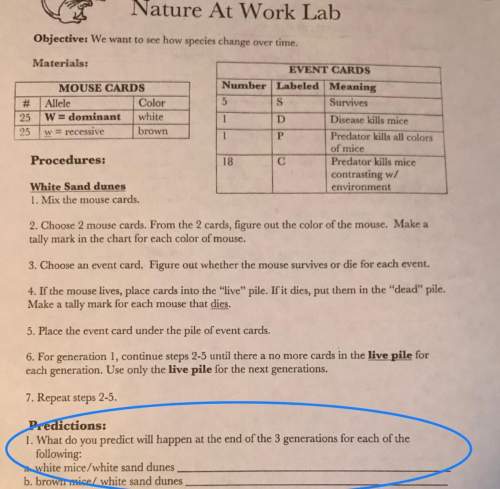

Answers: 1
Another question on Biology

Biology, 20.06.2019 18:02
Ineed ! when you answer this question, 98 points will be added to your account and the person that answers this question first will get the brainliest answer. so,here's the question the owners of a large tropical resort are considering a plan to destroy a large coral reef just offshore. they reason that, if the reef is gone, cruise ships will be able to dock closer to their resort and they will gain business. write a letter to the resort’s owners explaining how they might benefit more by preserving the reef instead.
Answers: 2

Biology, 22.06.2019 07:00
What would most likely happen if a person increased the amount of saturated fat in his or her diet? the person's risk of cardiovascular disease would increase. the person's risk of cardiovascular disease would decrease. the person's bad cholesterol would decrease. the person’s good cholesterol would increase.
Answers: 2

Biology, 22.06.2019 15:00
How do temperature and salinity affect deepwater currents? question 15 options: as temperatures and salinity levels of water increase, the water rises to the surface where it creates currents as it moves to colder regions. they create changes in wind direction, moving denser water in the same direction as the wind and causing the deepwater circulation patterns found in the ocean. they equalize the forces on undersea currents caused by the coriolis effect as they replace more dense water with less dense water. they create density differences that cause dense deepwater currents to flow toward the equator where they displace less dense, warmer water above them.
Answers: 2

Biology, 22.06.2019 17:30
98 points you will be galileo perform the experiment to determine if objects with different mass fall at the same, or different, rates in the air and in a vacuum. before you conduct your experiment, you need to form a hypothesis. a hypothesis is a prediction of what you think will happen in the experiment. the hypothesis is a statement that describes “if” a certain set of circumstances are present “then” there will be a specific result that will occur. record your hypothesis here: record the results from step one of the experiment (dropping the objects in the air): first trial: second trial: third trial: record the results from step two of the experiment (dropping the objects in a vacuum): first trial: second trial: third trial: did the experiment support your hypothesis? using the data from your experiment, describe why you believe your hypothesis was either proven or disproven. what forces were acting on the objects dropped in the air? what force was acting on the objects dropped in the vacuum? part two: comparing forces choose two forces and compare and contrast these forces. you must provide two ways that they are alike and two ways that they are different. you may make a list, write in paragraph form, or make a chart. choose two forces and compare and contrast these forces. these must be different forces than used in the prior question. provide two ways that they are similar and two ways that they are different. you may make a list, write it out, or make a chart.
Answers: 1
You know the right answer?
A mutation in a polypeptide with the original amino acid sequence of: Met-Ala-Gln-Arg-Glu-Leu result...
Questions

Mathematics, 10.02.2021 01:30

Geography, 10.02.2021 01:30

Arts, 10.02.2021 01:30

Biology, 10.02.2021 01:30

Mathematics, 10.02.2021 01:30

Mathematics, 10.02.2021 01:30

Mathematics, 10.02.2021 01:30


Health, 10.02.2021 01:30



Mathematics, 10.02.2021 01:30

Mathematics, 10.02.2021 01:30



Geography, 10.02.2021 01:30

English, 10.02.2021 01:30


Mathematics, 10.02.2021 01:30





